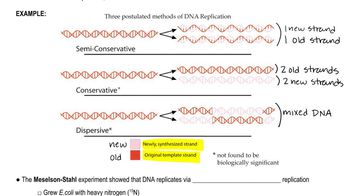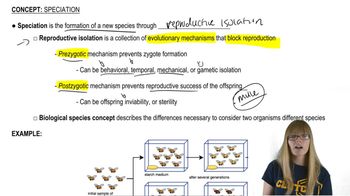Table of contents
- 1. Introduction to Genetics51m
- 2. Mendel's Laws of Inheritance3h 37m
- 3. Extensions to Mendelian Inheritance2h 41m
- 4. Genetic Mapping and Linkage2h 28m
- 5. Genetics of Bacteria and Viruses1h 21m
- 6. Chromosomal Variation1h 48m
- 7. DNA and Chromosome Structure56m
- 8. DNA Replication1h 10m
- 9. Mitosis and Meiosis1h 34m
- 10. Transcription1h 0m
- 11. Translation58m
- 12. Gene Regulation in Prokaryotes1h 19m
- 13. Gene Regulation in Eukaryotes44m
- 14. Genetic Control of Development44m
- 15. Genomes and Genomics1h 50m
- 16. Transposable Elements47m
- 17. Mutation, Repair, and Recombination1h 6m
- 18. Molecular Genetic Tools19m
- 19. Cancer Genetics29m
- 20. Quantitative Genetics1h 26m
- 21. Population Genetics50m
- 22. Evolutionary Genetics29m
8. DNA Replication
Overview of DNA Replication
Problem 25a
Textbook Question
How does rolling circle replication (see Section 6.2) differ from bidirectional replication?
 Verified step by step guidance
Verified step by step guidance1
Understand that rolling circle replication is a process often used by plasmids and some viruses, where replication starts at a single origin and proceeds in one direction, creating a single-stranded DNA circle.
Recognize that in rolling circle replication, a nick is made in one of the DNA strands, and the 3' end of the nicked strand serves as a primer for DNA synthesis, while the 5' end is displaced and forms a tail.
Compare this with bidirectional replication, which occurs in most prokaryotic and eukaryotic chromosomes, where replication starts at an origin and proceeds in two directions, forming a replication bubble.
Note that in bidirectional replication, two replication forks move away from the origin, synthesizing new DNA strands in both directions, which is different from the unidirectional nature of rolling circle replication.
Consider the implications of these differences: rolling circle replication is efficient for quickly producing multiple copies of small DNA molecules, while bidirectional replication is suited for larger, linear chromosomes.
Recommended similar problem, with video answer:
 Verified Solution
Verified SolutionThis video solution was recommended by our tutors as helpful for the problem above
Video duration:
2mPlay a video:
Was this helpful?
Key Concepts
Here are the essential concepts you must grasp in order to answer the question correctly.
Rolling Circle Replication
Rolling circle replication is a mechanism of DNA replication primarily observed in certain viruses and plasmids. In this process, a circular DNA molecule is nicked, allowing one strand to unwind and serve as a template for continuous synthesis of a new strand. This results in the formation of multiple copies of the circular DNA, which can be released as individual molecules.
Recommended video:
Guided course

Semiconservative Replication
Bidirectional Replication
Bidirectional replication is the standard method of DNA replication in most organisms, where replication begins at a specific origin and proceeds in two opposite directions. This process involves the formation of two replication forks that move away from the origin, allowing for simultaneous synthesis of new DNA strands on both sides. It ensures efficient and rapid duplication of the entire linear DNA molecule.
Recommended video:
Guided course

Semiconservative Replication
Differences in Mechanism
The primary difference between rolling circle and bidirectional replication lies in their mechanisms and outcomes. Rolling circle replication produces multiple copies of a circular DNA molecule from a single origin, while bidirectional replication results in the duplication of linear DNA from two origins. Additionally, rolling circle replication is continuous and unidirectional, whereas bidirectional replication involves the coordinated action of multiple enzymes at two forks.
Recommended video:
Guided course

Speciation

 5:02m
5:02mWatch next
Master Directionality with a bite sized video explanation from Kylia Goodner
Start learning



